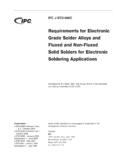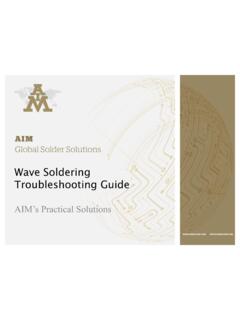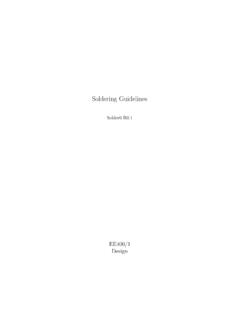Transcription of Practical Electronics Handbook
1 PRACTICALELECTRONICSHANDBOOKPRACTICALELE CTRONICSHANDBOOKSIXTHEDITIONIANR. SINCLAIR ANDJOHNDUNTONAMSTERDAM BOSTON HEIDELBERG LONDON NEW YORKOXFORD PARIS SAN DIEGO SAN FRANCISCOSINGAPORE SYDNEY TOKYON ewnes is an imprint of ElsevierNewnes is an imprint of ElsevierLinacre House, Jordan Hill, Oxford, OX2 8DP30 Corporate Drive, Burlington, MA 01803 First edition 1980 Reprinted 1982, 1983 (with revisions), 1987 Second edition 1988 Reprinted 1990 Third edition 1992 Fourth edition 1994 Reprinted 1997, 1998, 1999 Fifth edition 2000 Reprinted 2001 Sixth edition 2007 Copyright 1980, 1988, 1992, 1994, 2000, 2007, Ian R. Sinclair and John Dunton. Published by Elsevier rights reservedThe right of Ian R. Sinclair and John Dunton to be identified as the author of this work has been asserted inaccordance with the Copyright, Designs and Patents Act 1988No part of this publication may be reproduced, stored in a retrieval system or transmitted in any form or byany means electronic , mechanical, photocopying, recording or otherwise without the prior written permission ofthe publisherPermission may be sought directly from Elsevier s Science & Technology Rights Department in Oxford,UK: phone (+44) (0) 1865 843830; fax (+44) (0) 1865 853333; email: Alternativelyyou can submit your request online by visiting the Elsevier web site at ,and selectingObtaining permission to use Elsevier materialNoticeNo responsibility is assumed by the publisher for any injury and/or damage to persons or property as a matter ofproducts liability, negligence or otherwise, or from any use or operation of any methods, products, instructionsor ideas contained in the material herein.
2 Because of rapid advances in the medical sciences, in particular,independent verification of diagnoses and drug dosages should be madeBritish Library Cataloguing in Publication DataA catalogue record for this book is available from the British LibraryLibrary of Congress Cataloging-in-Publication DataA catalog record for this book is available from the Library of CongressCover photo by Thomas Scarborough, reproduced by permission of Everyday Practical Electronics . 13: 978-0-75-068071-4 ISBN 10: 0-75-068071-7 For information on all Newnes publications visit our web site at by Cepha LtdPrinted and bound in Great Britain0708091011 10987654321 ContentsvCONTENTSP refacexiiiIntroduction: Mathematical ConventionsxvCHAPTER1 Resistors1 Passive components1 Resistors2 Resistivity3 Resistivity calculations4 Resistor construction7 Tolerances and E-series9 Resistance value coding10 Surface mounted resistors13 Resistor characteristics13 Dissipation and temperature rise17 Variables and laws18 Resistors in circuit19 Kirchoff s laws20 The superposition theorem21 Thevenin s theorem23 Thermistors24 Variation of resistance with temperature26 CHAPTER2 Capacitors29 Capacitance29 The parallel-plate capacitor29 Construction31 Other capacitor characteristics36 Energy and charge storage39 Time constants39 Reactance43CR circuits45 CHAPTER3 Inductive and Tuned Circuit Components47 Inductors47 Transformers51viContentsSignal-matching transformers54 Mains transformers57 Other transformer types61 Surface-mounted inductors62 Inductance calculations64 Untuned transformers67 Inductive reactance68 LCR circuits68 Coupled tuned circuits73 Quartz crystals76 Temperature effects79
3 Wave filters79 CHAPTER4 Chemical Cells and Batteries83 Introduction83 Primary and secondary cells84 Battery connections85 Simple cell87 The Leclanch cell89 The alkaline primary cells92 Miniature (button) cells94 Lithium cells95 Secondary cells99 Nickel cadmium cells104 Lithium-ion rechargeable cells107 CHAPTER5 Active Discrete Components111 Diodes111 Varactor diodes115 Schottky diodes116 LEDs116 Photodiodes117 Transient voltage suppressors (TVS)120 Typical diode circuits122 Transistors122 Bias for linear amplifiers128 Transistor parameters and linearamplifier gain132 Transistor packaging136 Noise137 Voltage gain137 ContentsviiOther bipolar transistor types138 Darlington pair circuit139 Field-effect transistors139 FET handling problems143 Negative feedback144 Heatsinks148 Switching circuits150 Other switching devices154 Diode and transistor coding160 CHAPTER6 Linear ICs163 Overview163 The 741 op-amp165 Gain and bandwidth165 Offset166 Bias methods167 Basic circuits168 General notes on op-amp circuits171 Modern op-amps172 Other operational amplifier circuits173 Current differencing amplifiers176 Other linear amplifier ICs176 Phase-locked loops180 Waveform generators183 Active and switched capacitor filters185 Voltage regulator ICs189 Adjustable regulator circuits191 The 555 timer193 CHAPTER7 Familiar Linear Circuits197 Overview197 Discrete transistor circuits197 Audio circuits202 Simple active filters204
4 Circuits for audio output stages207 Class D amplifiers211 Wideband voltage amplification circuits214 Sine wave and other oscillator circuits216 Other crystal oscillators217 Astable, monostable and bistable circuits223 Radio-frequency circuits226 Modulation circuits230viiiContentsOptical circuits232 Linear power supply circuits233 Switch-mode power supplies236 CHAPTER8 Sensors and Transducers243 Introduction243 Strain and pressure244 Direction and motion246 Light, UV and IR radiation251 Temperature255 Sound260 CHAPTER9 Digital Logic265 Introduction265 Logic families269 Other logic families273 Combinational logic274 Number bases276 Sequential logic277 Counters and dividers283 CHAPTER10 Programmable Devices289 Memory289 Read-only memory (ROM)290 Programmable read-only memory (PROM)291 Volatile memory (RAM)294 Programmable logic296 Complex programmable logicdevices (CPLD)299 Field programmable gate array (FPGA)300 Hardware description language (HDL)301 Other programmable devices302 Other applications of memory devices303 Useful websites305 CHAPTER11 Microprocessors and Microcontrollers307 Introduction307 Binary stored program computers308 Von Neumann and Harvard architecture311 Microprocessor systems314 Power-up reset and program execution317 ContentsixProgramming318 The ARM processor320 Developing microprocessor hardware322 Electromagnetic compatibility325 Microcontroller manufacturers325 CHAPTER12 Microprocessor Interfacing327 Output circuits327 Display devices327 Light-emitting diode (LED) displays327 Liquid crystal displays (LCDs)332 Input circuits338 Switches338 CHAPTER13 Data Converters343 Introduction343 Digital-to-analogue converters (DACs)
5 344 Digital potentiometer345 Binary weighted resistor converter345 The R2R ladder347 Charge distribution DAC348 Pulse width modulator349 Reconstruction filter350 Analogue-to-digital converters351 Resolution and quantization352 Sampling356 Aliasing356 Successive approximationanalogue-to-digital converter358 Sigma delta ADC (over samplingor bitstream converter)360 Dual-slope ADC361 Voltage references for analogue-to-digitalconverters362 PCB layout363 Connecting a serial ADC to a PC363 Useful websites367 CHAPTER14 Transferring Digital Data369 Introduction369 Parallel transfer370 IEEE 1284 Centronics printer interface371xContentsThe IEEE-488 bus374 Serial transfer379 EIA/TIA 232E serial interface379RS-422/RS-485387 Wireless links390 Infra-red390 Audio frequency signalling391 Base-band signalling391 Error detection and correction396 Useful websites398 CHAPTER15 Microcontroller Applications399 Introduction399 Configuration401 Clock401 Internal RC oscillator402 Watchdog and sleep404 Power-up reset405 Setting up I/O ports407 Integrated peripherals410 Counter timer410 Pulse width modulator411 Serial interfaces412 UART/USART412 SPI/I2C Bus413 Interrupts419 Implementing serial output in software420 Converting binary data to ASCII hex422 Useful websites424 CHAPTER16 Digital Signal Processing425 Introduction425 Low-pass and high-pass
6 Filters426 Finite impulse response (FIR) filters431 Quantization432 Saturated arithmetic432 Truncation433 Bandpass and notch filters434 Infinite impulse response (IIR) filters434 Other applications436 Design tools437 Further reading438 ContentsxiCHAPTER17 Computer Aids to Circuit Design439 Introduction439 Schematic capture440 Libraries441 Connections446 Net names447 Virtual wiring448 Net lists451 Printing454 Simulation455 Analysis456DC Analysis457 Temperature sweep459AC Analysis461 Transient analysis462 PCB layout467 Design rules472 Gerber and NC drill file checking477 Desktop routing machines477 Useful websites479 CHAPTER18 Connectors, Prototyping and Mechanical Construction481 Hardware481 Video connectors486 Audio connectors487 Control knobs and switches492 Switches493 Cabinets and cases496 Handling497 Heat dissipation500 Constructing circuits501 soldering and unsoldering508 Desoldering512 Other soldering tools514 CHAPTER19 Testing and Troubleshooting517 Introduction517 Test equipment517 Test leads517 Power supplies and battery packs518 Digital multimeters519 LCR meter522xiiContentsOscilloscope522 Signal generator526 Temperature testing527 Mains work527 Testing529 Further reading530 Appendix AStandard Metric Wire Table531 Appendix BArithmatic and Logic Instructions Table533 Appendix CHex record formats537 Appendix DGerber data format543 Appendix EPinout information links553 Appendix FSMT packages and guides555 Index557 PrefacexiiiPrefaceComponent data books are often little more than collections of specifica-tions with little or nothing in the way of explanation or application and,in many cases.
7 With so much information crammed into a small space thatthe user has difficulty in selecting what is needed. The cost of publishingpaper data books, the rate that new products are being brought to marketand the ease with which electronic copies of data sheets can be distributedby e-mail or downloaded from websites has begun to deter manufacturersfrom printing data books at all. This book, now in its sixth edition, hasbeen extensively revised, with a large amount of new material added, toserve the needs of both the professional and the enthusiast. It combinesdata and explanations in a way that is not served by the book is not intended as a form of beginners guide to thewhole of Electronics , the beginner will find much of interest in the earlychapters as a compact reminder of electronic principles and circuits. Theconstructor of electronic circuits and the service engineer should both findthe data in this book of considerable assistance, and the professional designengineer will also find that the items brought together here include manythat will be frequently useful and which would normally be available incollected form in much larger book has been designed to include within a reasonable space mostof the information that is useful in day-to-day Electronics together withbrief explanations which are intended to serve as reminders rather thanfull descriptions.
8 In addition, topics that go well beyond the scope ofsimple Practical Electronics have been included so that the reader has accessto information on the advanced technology that permeates so much ofmodern SINCLAIRJOHNDUNTONI ntroductionxvINTRODUCTION:MATHEMATICSCON VENTIONSQ uantities greater than 100 or less than are usually expressed in thestandard formofA 10n, whereAis a number, called themantissa,less than 10, andnis a whole number called theexponent. A positivevalue ofnmeans that the number is greater than unity, a negative valueofnmeans that the number is less than unity. To convert a number intostandard form, shift the decimal place until the portion on the left-handside of the decimal point is between 1 and 10, and count the number ofplaces that the point has been moved. This is the value ofn. If the decimalpoint has had to be shifted to the left the sign ofnis positive; if the decimalpoint had to be shifted to the right the sign ofnis :1200 is 103and is 10 3To convert numbers back from standard form, shift the decimal pointnfigures to the right ifnis positive or to the left ifnis 10 4= and 105=680 000 Note in these examples that a space has been used instead of the morefamiliar comma for separating groups of three digits (thousands and thou-sandths).
9 This is recommended engineering practice and avoids confusioncaused by the use, in other languages, of a comma as a decimal in standard form can be entered into a calculator by using thekey marked Exp or EE for details see the manufacturer s formulae are to be worked out, numbers in standard form canbe used, but for writing component values it is more convenient to usethe prefixes shown in the table below. The prefixes have been chosen sothat values can be written without using small fractions or large variants of standard form follow a similar pattern in allowing numbersbetween 1 and 999 to be used as the whole-number part of the expression,so that numbers such as 147 10 4are used. A less common conventionis to use a fraction between and 1 as a mantissa, such as of 10 and prefixesPrefixAbbreviationPower of tenMultiplierGigaG1 000 000 000 MegaM1 000 000kilok1000millim1/(1000)microm1/(1 000 000)nanon1/(1 000 000 000)picop1/(1 000 000 000 000)Notethat 1000 pF=1 nF; 1000nF=1mF and so on.
10 In computing, theK symbol means 1024 rather than 1000 and M means 1 048 576 thesequantities are the nearest exact powers of :1kW=1000W(sometimes written as 1 K0, see pages 7-8)1nF= ,1000 pF or 10 MHz=4500 kHz= 106 HzThroughout this book equations have been printed in as many forms asare normally needed so that the reader should not have to transpose theequations. For example, Ohm s law is given in all three familiar forms ofV=IR,R=V/IandI= units that must be used with suchformulae are shown and must be adhered to if no units are quoted thenfundamental units (amp, ohm, volt) are example,the equationX=1/(2pfC)is used to find the reactance of acapacitor in ohms, usingCin farads andfin hertz. If the equation is to beused with values given inmF and kHz then values of and 15 kHzare entered as 10 6and 15 , the equation can bewritten asX=1/(2pfC)MWusing values offin kHz andCin all equation multiplication is normally indicated by the use of a dot, by close printing as shown above in 2pfC.









